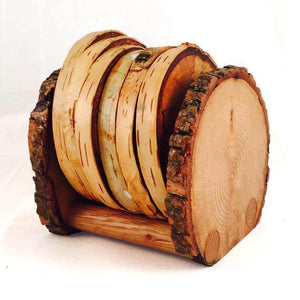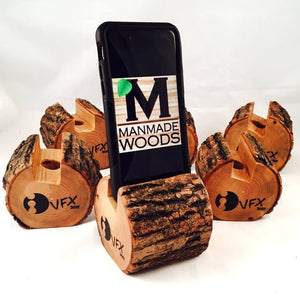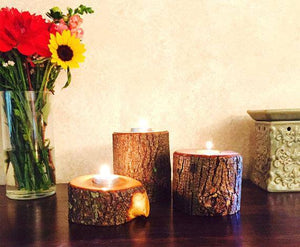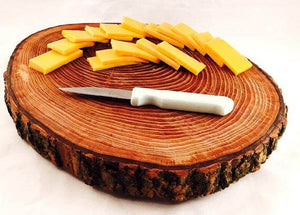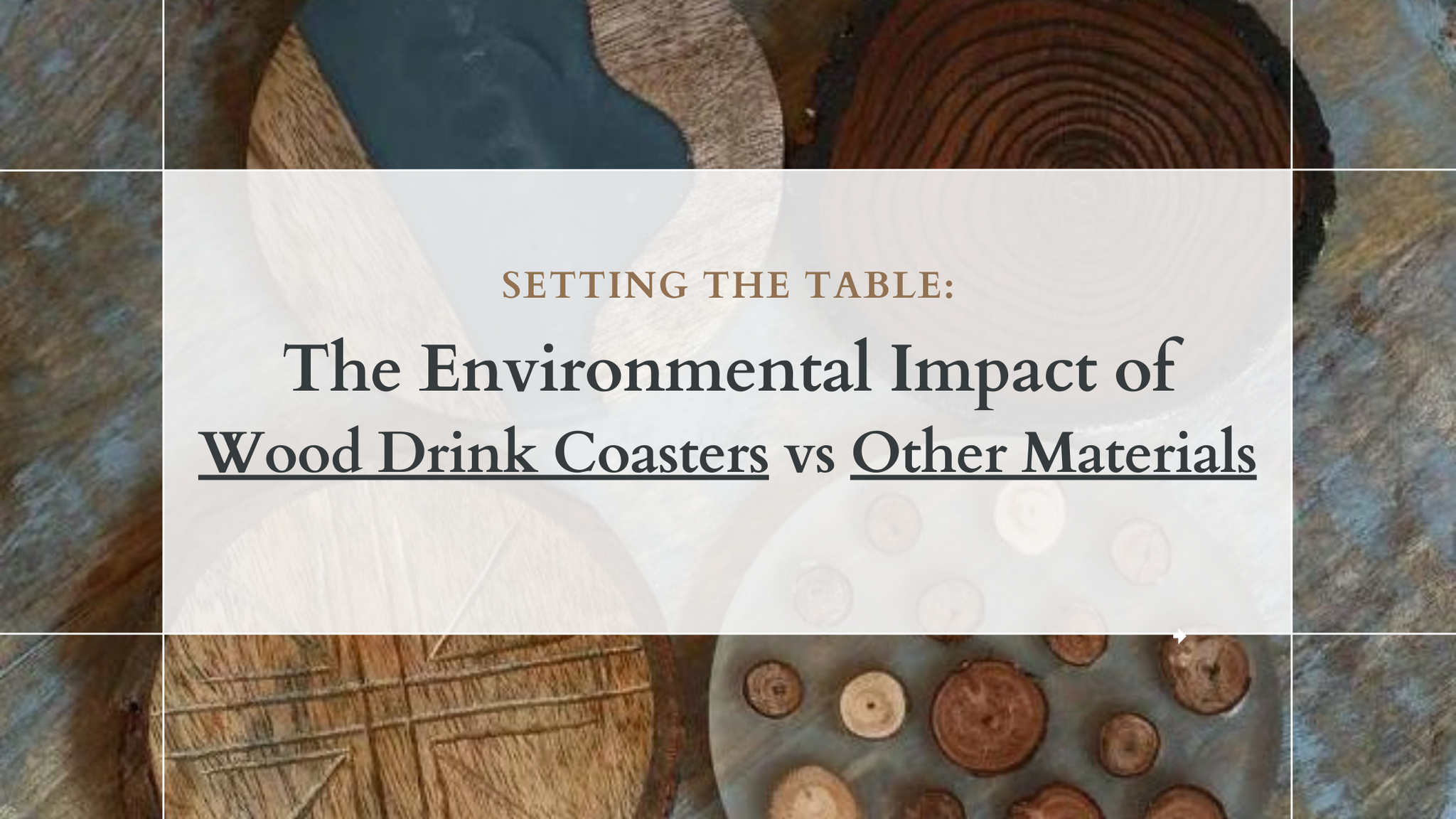Setting the Table: The Environmental Impact of Wood Drink Coasters vs Other Materials
In the hustle and bustle of our modern lives, it's easy to overlook the profound impact our everyday choices have on the environment. Yet, as I found myself standing in the grocery aisle, pondering between organic and conventionally grown produce, the realization dawned upon me: every decision I make holds the potential to shape the world around me.
As someone deeply passionate about sustainability, I've made it my mission to tread lightly on the planet, from reducing single-use plastics to embracing renewable energy. But recently, I stumbled upon a topic that piqued my curiosity and led me down a rabbit hole of research: drink coasters. Yes, those seemingly inconsequential discs that grace our tables during moments of leisure and conviviality.
The Environmental Impact of Wood Drink Coasters
Wood, with its rich history and timeless charm, has always fascinated me. Beyond its aesthetic appeal, I've come to appreciate its inherent eco-friendliness. Delving into the world of wood drink coasters, I discovered a story of sustainability and stewardship.
Unlike materials derived from fossil fuels or mined from the earth, wood embodies a natural cycle of renewal. Sourced from responsibly managed forests, wood coasters carry with them the legacy of sustainable forestry practices. Programs like the Forest Stewardship Council (FSC) provide assurance that every wooden coaster originates from forests managed with the utmost care and respect for biodiversity.
But what truly captured my imagination was the journey of a wood coaster at the end of its lifecycle. Unlike their plastic counterparts destined for eternity in landfills, wood coasters gracefully bow out, returning to the earth from whence they came. Biodegradable and compostable, they complete a full circle, embodying the essence of sustainability in its purest form.
As I sipped my morning coffee, adorned with a wooden coaster, I couldn't help but marvel at the harmony between nature and everyday life. Each ring on the coaster's surface whispered tales of sun-dappled forests and gentle breezes, reminding me of the intricate web of life we're all a part of.
Other Materials Used for Drink Coasters
As I continued my quest for sustainable alternatives in the realm of drink coasters, I found myself venturing into uncharted territory, exploring the diverse landscape of materials beyond wood. What I uncovered was a tapestry of options, each weaving its own story of environmental impact.
Plastic: Oh, plastic. So ubiquitous yet so detrimental to our planet's health. Derived from fossil fuels through processes that ravage our environment, plastic coasters embody the very essence of our throwaway culture. As I pondered the sight of plastic coasters adorning tables in cafes and restaurants, I couldn't help but feel a pang of sadness for the future they represent—a future marred by plastic pollution and environmental degradation.
Cork: The gentle texture of cork coasters has always held a certain allure for me. Biodegradable and derived from the bark of cork oak trees, cork seems like a natural choice for eco-conscious consumers. Yet, as I delved deeper, questions arose about the sustainability of cork harvesting. With concerns about habitat destruction and biodiversity loss looming, the story of cork coasters became one of complexity and nuance.
Ceramic and Metal: As I gazed upon the sleek surfaces of ceramic and metal coasters, I couldn't help but admire their aesthetic appeal. Yet, beneath their polished exteriors lay a tale of resource-intensive production processes. From the energy-intensive firing of ceramics to the extraction and processing of metal ores, these coasters carry with them a heavy environmental burden. And while some may find solace in the durability of ceramic and metal, the reality is that their end-of-life disposal often leads to further ecological strain.
As I surveyed the vast array of coaster materials before me, I couldn't help but feel a sense of awe and wonder at the diversity of nature's offerings. Each material, whether wood or plastic, cork or ceramic, held within it a story waiting to be told – a story of resilience and adaptation, of innovation and stewardship.
In the end, as I reached for my trusty wooden coaster, its smooth surface worn with the passage of time, I couldn't help but feel a sense of gratitude for the simplicity and sustainability it embodied. And as I set my cup down upon its surface, I knew that I had made not just a choice, but a statement – a statement of my commitment to treading lightly on this precious planet we call home.
Embarking on our journey to uncover the environmental footprints of drink coasters, we immerse ourselves in a complex web of factors that influence their sustainability. Let's dive deeper into the comparative analysis, examining the intricacies that set wood coasters apart from their counterparts:
Material Extraction and Production:- Wood Coasters: Sourced from responsibly managed forests, wood coasters boast a low environmental impact from extraction to production.
- Plastic Coasters: Derived from fossil fuels, the extraction and production of plastic coasters contribute significantly to carbon emissions and pollution.
- Wood Coasters: With minimal processing requirements, wood coasters consume less energy during production compared to alternatives.
- Ceramic and Metal Coasters: The firing and shaping processes involved in ceramic and metal coaster production demand substantial energy inputs.
- Wood Coasters: The production of wood coasters typically involves less water usage compared to alternatives like ceramic.
- Cork Coasters: Cork harvesting requires minimal irrigation, making it a water-efficient option for coaster materials.
- Wood Coasters: Biodegradable and compostable, wood coasters leave minimal waste at the end of their lifecycle.
- Plastic Coasters: Non-biodegradable and challenging to recycle, plastic coasters contribute to the growing problem of plastic pollution.
In this comparative analysis, wood emerges as a frontrunner in sustainability, owing to its renewable nature and minimal processing requirements. By choosing wood coasters over alternatives, consumers can significantly reduce their environmental footprint and contribute to a healthier planet!
Beyond the choice of material, several factors influence the overall environmental impact of drink coasters. Let's explore these considerations and their implications for sustainability:
Transportation Distance:- Opting for locally sourced coasters reduces carbon emissions associated with transportation.
- Choosing wood coasters from nearby forests further minimizes the environmental impact of transportation.
- Coasters produced in facilities powered by renewable energy sources have a lower carbon footprint.
- Selecting manufacturers with stringent environmental standards ensures responsible production practices.
- Durable coaster designs prolong the lifespan of products, reducing the need for frequent replacements.
- Investing in high-quality coasters, such as those made from wood, ensures longevity and sustainability.
By considering these factors and making informed choices, consumers can amplify their impact on environmental sustainability. Whether it's opting for locally sourced wood coasters or supporting manufacturers committed to eco-friendly practices, every decision counts in shaping a more sustainable future.
When it comes to purchasing drink coasters, there are myriad factors to consider. From the materials used to the manufacturing processes employed, every aspect of a coaster's lifecycle has implications for the environment. This is where your conscientious consumerism comes into play.
Consider certifications as your guiding light through the maze of eco-friendly claims. Certifications like the Forest Stewardship Council (FSC) ensure that wood products, including coasters, come from responsibly managed forests. These certifications are more than just labels; they represent a commitment to sustainability from forest to table.
But certifications are just the beginning. Dive deeper into the manufacturing practices of the brands you support. Do they prioritize renewable energy? Do they minimize waste and emissions? By asking these questions, you're holding companies accountable and pushing them towards greener practices.
And of course, there's the product itself. We invite you to consider our wood coasters, not just as functional accessories, but as symbols of elegance and sustainability. Crafted with care from renewable resources, our coasters embody the harmony between nature and design. Each time you place a glass on one of our coasters, you're making a statement – a statement that beauty and sustainability can coexist!
And so, we extend to you an invitation – an invitation to join us in our mission towards a more sustainable future. With our special offer of planting one tree for every coaster or wood product purchased in our shop, we're not just selling coasters; we're planting seeds of change. Together, we can turn the tide towards a future where every coaster choice leaves a positive mark on the planet!
So let's raise our glasses, not just in celebration, but in solidarity with the earth. Cheers to sustainability, to conscious consumerism, and to a brighter tomorrow for all. Let's make every sip count!

